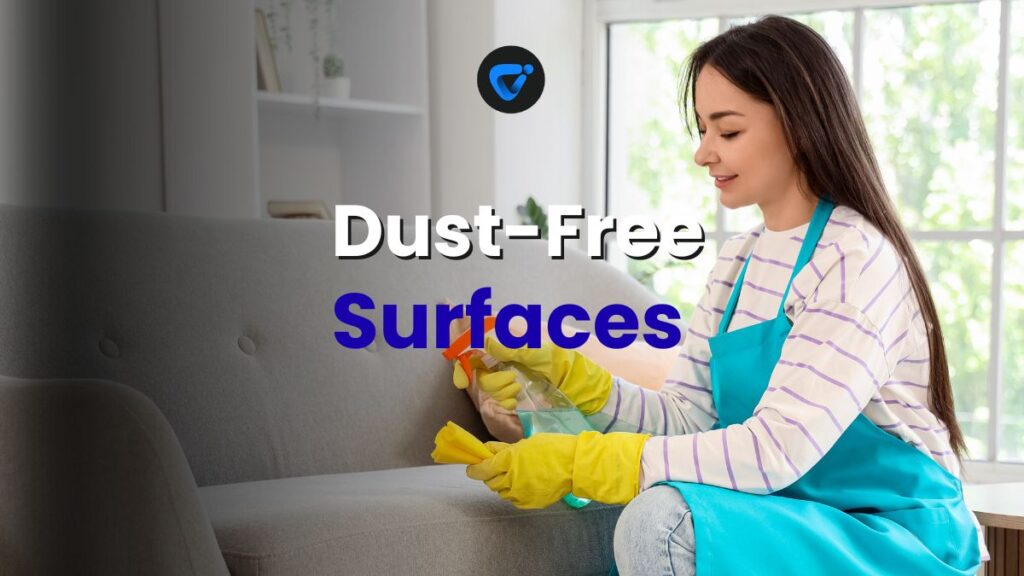
Notice how a sparkling coffee table turns dull with a fine film just hours after cleaning? Keeping a dust free living room can feel like a battle against invisible forces, leaving you frustrated when all your effort disappears so quickly.

Simple Lubrication Tips for Sliding Doors
Keep doors gliding smoothly! Follow these simple lubrication tips to fix sticking sliding doors fast. Read on and learn more!
Dust doesn’t just dull your decor. It can trigger allergies, cling to electronics, and whisper to guests that you just might be behind on chores. Understanding what makes dust settle—and how to fight back—transforms cleaning from a short-lived reset into sustained satisfaction.
Within these micro-guides, you’ll discover routines, product tips, and workflow tweaks for making your living room dust free longer than you thought possible. Dive in for actionable habits that work in any busy home.
Daily Touchpoints That Make or Break Clean Surfaces
Targeting repeat dust hotspots daily sets the foundation for a consistently dust free living room. This habit keeps particle buildup small and manageable instead of letting it take hold over the week.
The first step is to identify which surfaces feel rough first—TV stands, coffee tables, and shelving are common culprits. Focus regular attention where dust appears fastest so you maximize the visible payoff.
Identifying Your Dust Source Zones
Start by crouching at eye level with your surfaces in daylight. Notice where light catches floating or resting dust. Most households say, “My black shelf shows specks every morning” or “The TV stand looks gritty after one night.” Mark these zones mentally.
Take five minutes to glide your hand over these areas. If your fingers pick up pollen, flakes, or fuzz before the rest of the room, that’s a primary dust source. Convert this map into a daily go-to list to address dust where it loves to collect first.
Use a post-it checklist or a voice reminder, like “Wipe the end table by the window, TV stand, and bookshelf before breakfast.” This targeted strategy prevents feeling overwhelmed by the scale of the whole room every day.
Maintaining Habits With a Visual Cue
Place a microfiber cloth in a visible spot—such as a small tray by your remote control. When you grab your remote, the cloth serves as a non-verbal nudge: “Wipe me first.” This visual cue creates a habit loop, where seeing triggers doing.
The more often you connect a cue to a simple wipe-down, the quicker your response becomes automatic. Over time, these micro-actions keep dust free living room goals in sight and steadily maintained.
By linking dusting with routine moments like turning on a lamp or starting the news, you normalize quick surface resets. Copy this approach: “When I sit on the couch, I swipe the end table.” Automate the process to make it effortless.
| Surface Type | Frequency Needed | Best Cleaning Tool | Takeaway for Longer Results |
|---|---|---|---|
| Glass | Daily to Every Other Day | Microfiber Cloth | Buff in gentle circles to trap dust, avoid paper towels |
| Wood | Every 2–3 Days | Electrostatic Duster | Wipe with grain, finish with conditioner to repel |
| Electronics | Twice Weekly | Dry High-Performance Cloth | Unplug first, use swift movements, avoid moisture |
| Fabric Upholstery | Weekly | Vacuum Brush Attachment | Sweep seams, cushions, edges to trap fine dust |
| Metal/Lamp Bases | Every 3 Days | Antistatic Wipe | Go over switches and bases where hands touch |
Choosing Tools That Trap, Not Push, Dust Away
Switching to the right cleaning tools means less swirling dust in the air and more captured grime. These choices deliver a noticeably dust free living room for days longer than basic towels or all-purpose cloths.
Upgrade from feather dusters and old T-shirts to microfiber and electrostatic dusters for dramatically better results. The right materials act like magnets, pulling dust in without letting it back out when you move on.
Product Pointers: Microfiber vs. Electrostatic
Microfiber grabs microscopic particles, clinging thanks to split fibers. Glide gently—avoid scrubbing. Electrostatic dusters use a static charge; swipe in smooth lines with light pressure for fast, effective dust pickup.
- Reach for a damp microfiber cloth on flat surfaces to keep dust particles caught instead of lifting and moving elsewhere. Don’t soak the cloth—just damp.
- Use an electrostatic duster under electronics and baseboards where static naturally makes dust stick. Aim for slow, even passes.
- Clean microfiber cloths by shaking outdoors or rinsing frequently in plain water. They work best when dust-free themselves.
- Swap feather dusters for these tools—feathers scatter dust more than they collect. You’ll notice an immediate drop in airborne particles.
- Keep one microfiber for dusting and another for polishing. Cross-use causes buildup and dulls your furniture finish.
Within a week, you’ll spot fewer streaks and see dust-free living room surfaces last longer than if you’d stuck to disposable wipes or paper towels.
Flawless Finishes: Polishing for Protection
Protective polishes and conditioners build a shield on your surfaces, making it harder for dust to settle and stick. Think of it as putting on rain gear before heading into a downpour—it adds a proactive layer.
- Apply lemon oil or a specialized wood conditioner after dusting wood furniture. This prevents static cling and extends time between cleanings.
- For glass, use anti-static sprays with a microfiber cloth to deter dust from resettling after you clean. Check for residue by tilting surfaces against the light.
- Switch to fragrance-free products to avoid sticky buildup, which attracts even more dust. Less residue means easier upkeep.
- Buff surfaces in the same direction as cleaning, whether it’s with the grain on wood or top-to-bottom for glass. This cuts down on visible streaks.
- Dedicate tools for each kind of polish so cross-contamination doesn’t dull the finish. Keep a labeled bin or drawer to organize them.
Adding just one finishing touch per session reduces cleaning sessions later, helping your dust free living room routine thrive with minimal extra effort.
Improving Air Quality to Support Cleaner Surfaces
Enhanced air quality directly reduces the dust that lands on your living room’s surfaces. By filtering out airborne particles, you support every effort to achieve a reliably dust free living room day after day.
Purifiers and HVAC tweaks deliver tangible results, especially in homes with pets, high traffic, or exterior-facing doors and windows. Small improvements here compound your cleaning success every day.
Adding Air Filtration for Lasting Results
Install a HEPA-quality air purifier in the core of your living room. Run it several hours daily—especially when windows are open or vacuuming. Watch airborne dust fade in rooms where filtration runs longer before and after social gatherings.
Replace HVAC and vent filters every two to three months. Mark your calendar or set reminders. Many allergy sufferers say, “After a filter swap, I wipe my shelf half as much.” The benefit accumulates quickly with regular swaps.
If allergies persist or you notice dust returning overnight, bump up your purifier’s run time. Move filters closer to seating or entry zones for direct support. Even modest upgrades yield a noticeably dust free living room in under one week.
Adjusting Humidity for Less Static
Dry conditions amplify static, helping dust stick to every piece of furniture. Maintain a room humidity level between 40% and 50%. This sweet spot makes dust settle faster—where you can wipe it away—instead of becoming airborne for hours.
Use a digital hygrometer to track moisture levels daily, especially in winter with heat running. If readings dip, bring in a humidifier. Focus on visible cues, like—”My glass table stays clean a whole day longer with balanced humidity.”
Always empty and clean water tanks to prevent mold growth. Make a quick schedule: “Refill and rinse weekly with vinegar water.” This keeps your solution as dust free as your living room itself.
Managing Entry Points to Prevent New Dust Intrusion
Minimizing new dust at your living room’s entry zones stops problems before they start. Block, trap, and redirect particle entry for a more consistently dust free living room experience—every guest and every season.
Think of your entry ways as floodgates; installing the right blockers and routines stops the invisible stream of grit and pollen that rides on shoes, bags, pets, or the wind.
Setting Up Tactical Entryway Habits
Place entry mats both outside and inside your main door. Shake or vacuum mats weekly, not just after visible dirt. Say out loud: “Step-scrape-shuffle before shoes cross my living room rug.” This reinforces the habit anytime you or kids arrive home.
Store shoes, boots, and pet paws-cleaning wipes right by the entry. Use an open bench or rack, so the visual cue prompts everyone, turning “Shoes off at the door” from nagging into norm. Regularly empty mat debris outside, not in living room bins.
Install weather stripping on doors and windows for an invisible defense. This blocks airborne pollen and street dust before it drifts inside. Rattling windows? Weather strips seal gaps, muting noise and blocking grit with a single upgrade.
Organizing and Maintaining Decor for Less Dust Buildup
Streamlined decor and mindful object placement make it easier to achieve a dust free living room over weeks, not just hours. Clusters of books, trinkets, and collections act as mini dust traps—adjust these, and you increase cleaning speed while decreasing buildup.
Choose open shelves with fewer items instead of crowded displays. Larger objects are simpler to dust in one swipe, while crowded decor needs fussy attention, making daily dust maintenance less inviting and more time-consuming.
Declutter Method: 10-Second Rule
Follow the 10-second rule when you pick up any decor piece: if it can’t be wiped in 10 seconds, remove or relocate it. This keeps your high-traffic shelves lean and quick to reset, letting dusting routines stay short and sweet.
Rotate displayed items seasonally. When you unpack spring or holiday decor, clean off each piece before setting out. This keeps old settled dust from re-entering the living room—and makes each setup feel fresh and tidy.
Group lightweight or rarely used items in closed cabinets or glass displays when possible. This protects them and keeps dust confined inside enclosures rather than swirling over open shelves, especially in busy or kid-filled homes.
Smart Storage for Dust Defense
Use decorative bins, boxes, and baskets with tight lids. Place them beneath coffee tables or beside couches for a stylish curb against daily dust. Opt for fabric bins you can toss into the wash every month.
If you collect magazines or mail, rack them upright. Flat stacks invite dust; upright storage reduces surface area for dust to rest on, and speeds up sorting chores every week.
Mark a calendar to clear out and wipe these storage solutions monthly. Setting a routine keeps hidden dust free living room progress high and hidden allergens low.
Strategic Cleaning Sequences for Lasting Results
Working in the right cleaning order lets you lock in a dust free living room look for longer. Cleaning from top to bottom and dry to wet ensures no step undoes another, saving time and multiplying each session’s impact.
Copy effective pro cleaner sequences: start with high shelves and fans, then move down to coffee tables and finally the floor. Always finish with soft fabric and electronics last, since these grab the most airborne dust kicked up earlier.
Top-Down Cleaning Flow
Tackle ceiling fans and upper shelves first with a duster, followed by framed art or wall decor. Note where clumps fall as you clean; this cues you to where the next pass should focus.
Move to mid-levels like TVs, mantels, and consoles. Wipe all surfaces before picking up remotes or small items. This stepwise approach prevents re-dusting areas you’ve already covered, locking in that dust free living room finish.
Finally, vacuum or wipe the floor and soft fabrics. Go slow to lift dust from baseboards and beneath couches, then finish by checking light switches and door handles for sneaky buildup, leaving no surface behind.
Rapid Reset: 10-Minute Routine
Set a timer for 10 minutes in the evening. Wipe high-traffic zones, electronics, and remotes. Flip cushions or use a roller on exposed fabric. This habit maintains a dust free living room quickly without a big effort.
Encourage family buy-in with a group “reset.” Assign everyone a surface or task, such as “You do the lamp base, I’ll take the shelf.” Quick teamwork makes it fun, finishes faster, and distributes the habit evenly.
Keep a basket of supplies central so it’s easy to grab and go. Return tools immediately once done; keeping your workflow organized doubles the impact of every cleaning session.
Building a Room-Wide Dust Defense Mindset
Staying dust free isn’t a one-time push—it’s maintaining simple micro-habits repeatedly, so each day builds on yesterday’s gains. Making this your mindset shifts the goal from endless catch-up to sustainable results, week in and week out.
Adopt the language: “Let’s keep our living room dust free longer by working smarter, not harder.” Coach yourself and housemates to spot and celebrate dust-free wins so the work feels rewarding, not like an endless loop.
Every visible, streak-free surface motivates another round of small maintenance steps. In time, these steady habits replace the feeling of always “starting over” and turn dust management into just another invisible part of your daily flow.
Frequently Asked Questions
Wipe with microfiber or electrostatic cloths, follow a top-down sequence, and add a daily 10-minute reset. Upgrade air filters and entryway mats to cut new dust at the source.
Electronics build up static, which magnetizes dust from the air. Unplug, dust with a dry microfiber cloth, and use antistatic wipes to reduce future buildup. Keep them raised off the floor when possible.
Choose residue-free, anti-static sprays and natural wood conditioners in moderation. Don’t overuse, as sticky residue attracts more dust. Use one cloth for applying and a clean one for buffing off excess.
Yes, pet dander and shed fur increase household dust. Brush pets outside, vacuum upholstery and floors often, and add washable throws as barriers to make your dust free living room routine easier to sustain.
Prioritize HEPA filters, switch to fragrance-free cleaning products, and maintain consistent humidity. Dust every other day, avoid feather dusters, and wear a dust mask during deep cleans to minimize reactions.

Unclogging Slow Drains
Unclog slow drains naturally! Use simple household methods to clear buildup without harsh chemicals or plumber costs.


